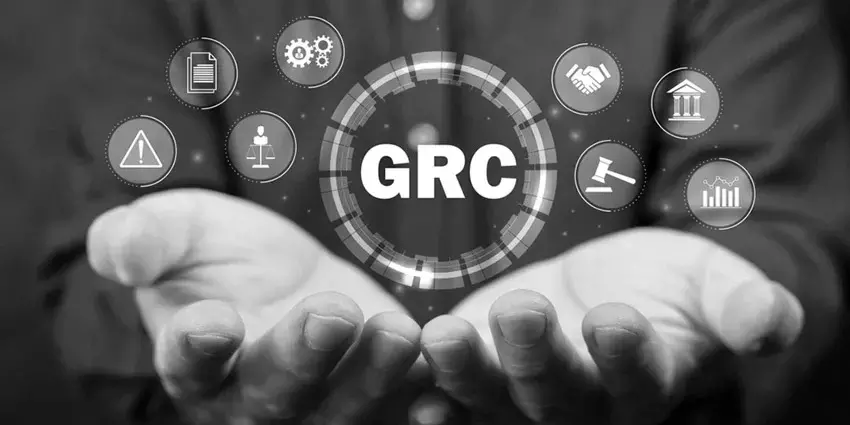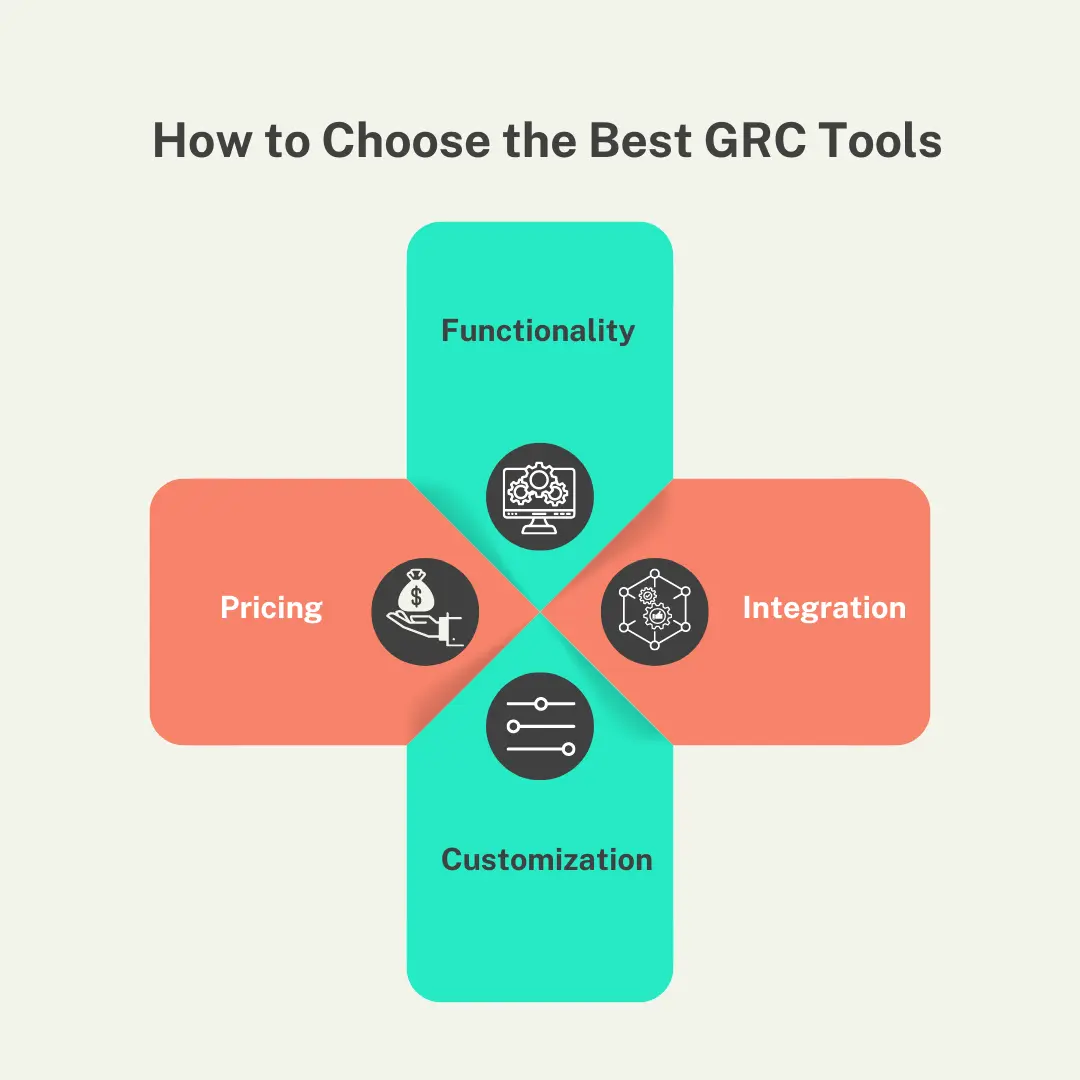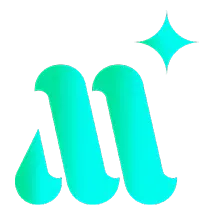Top 5 Governance, Risk, and Compliance (GRC) Tools and Solutions for 2025
- GRC
- 12 December 24

Introduction
You've heard it before: technology moves fast. But when it comes to governance, risk, and compliance (GRC), falling behind the curve can spell disaster. That's why staying on top of the latest GRC tools is crucial for any organization that values data security and operational resilience.
The stakes only get higher as cyber threats evolve and regulations intensify in a world that is becoming more diverse even as it stays more connected. Thankfully, new solutions are emerging to help enterprises tackle tomorrow's challenges.
An Increasing Need for GRC Tools
But why this seismic shift toward an increasingly regulated corporate ecosystem? This landscape has always been woven with threads of past financial debacles, data breaches, and government failures. The US market, known for its dynamic regulatory environment, witnessed substantial regulatory changes, significantly altering the way businesses approach governance, risk management, and compliance. This transformation can be attributed to a combination of factors - technological advancements, economic shifts, and societal demands for greater corporate responsibility.
The palpable push towards a more regulated financial ecosystem came in the wake of the financial crises of the early 21st century, namely the 2008 recession. These crises exposed the dire consequences of lax oversight and unbridled risk-taking, serving as a stark reminder that in the world of business, oversight is not merely about ticking off a checklist but safeguarding the future. A catastrophe of this nature sparked a profound reassessment within the industry, catalyzing a renewed emphasis on the necessity of robust GRC frameworks—navigators that understand the depths of these challenges and are ready to evolve with them.
What are GRC Tools?
A GRC (Governance, Risk, and Compliance) tool is a software application that businesses use to manage, assess risks, analyze policies, adhere to regulatory changes, and streamline operations. A GRC tool can help automate various aspects of a GRC framework.
GRC tools play a pivotal role in enabling businesses to assess, monitor, and mitigate risks, establish robust internal controls, ensure adherence to regulatory requirements, and uphold organizational policies. By consolidating disparate functions into integrated platforms, GRC tools provide a holistic view of risk exposure, facilitate data-driven decision-making, and enhance overall governance effectiveness.
Top 5 GRC Tools in 2025
Let's have a look at the top GRC tools that are reshaping governance, risk management, and compliance practices:
MetricStream
MetricStream is a highly regarded, comprehensive governance, risk, and compliance (GRC) tool renowned for its versatile approach to integrating risk, compliance, audit, and cybersecurity functions within organizations. The GRC tool stands out for its exceptional capability in simplifying complex risk management processes. The MetricStream ConnectedGRC platform stands out for its ability to seamlessly synchronize operations across disparate departments, presenting a unified defense against multifaceted risks in today's interconnected landscape.
Key Features:
- MetricStream offers a centralized platform that integrates risk, compliance, audit, and cyber risk functions, providing organizations with a holistic view of their governance landscape. A single tool that can streamline all your GRC processes, including Risk Management (Operational Risk, Enterprise Risk, Third-Party Risk), Compliance Management, Policy Management, Case Management, Audit Management, IT & Cybersecurity Risk Management and ESG.
- Infused with state-of-the-art analytics and AI capabilities, MetricStream empowers businesses to embrace and implement GRC best practices efficiently. The flagship solution AiSPIRE is an AI-based GRC knowledge center that provides intelligent insights into Control Insights, Continuous Control Sensing, Control Test Prioritization, and more.
- MetricStream comes with standout features including:
- Regulatory change management automation with AI-based regulatory alerts, horizon scanning, and impact analysis
- Natural Language Processing (NLP) customized policy searches based on user intent
- Risk quantification to represent IT and enterprise risk exposures in monetary terms
- Continuous control monitoring of IT controls to automate compliance and proactively mitigate security risks
- MetricStream features low-code/no-code capabilities, allowing organizations to tailor the platform to their specific needs with minimal effort leading to accelerated implementation and customization.
- The tool is adept at handling Environmental, Social, Governance, Risk, and Compliance (ESGRC) complexities, enabling organizations to pursue sustainable growth with integrity. It effortlessly oversees the demands of diverse ESG frameworks such as GRI, SASB, TCFD, and more, streamlining operations through automated data capture and reporting.
- MetricStream conducts thorough internal and supplier evaluations while proactively managing and mitigating associated risks. This allows for informed decision-making and strategic risk reduction.
- The software streamlines and optimizes internal audit operations, facilitating efficient audit planning, workpaper management, and thorough analysis of findings. This in turn supports the entire audit lifecycle from planning and execution to report generation and follow-up actions.
MetricStream's market leader position has been vetted by leading analysts like Forrester, Gartner, Chartis, and IDC MarketScape. The most recent recognition is as a Leader in the IDC MarketScape Worldwide Governance, Risk, and Compliance Software 2025 Vendor Assessment report. The IDC MarketScape report emphasizes MetricStream’s core strengths, stating: “MetricStream has a strong strategic direction and roadmap that will consistently deliver value to customers. The company's AI capability will see an accelerated increase in customer productivity and outcomes, further enhancing the ROI of the platform.”
Find out more. Download the report excerpt covering MetricStream.
See what customers have to say about MetricStream: Watch our Customer Testimonials
Pricing
Pricing is available at request.
AuditBoard
AuditBoard serves as a companion for auditors and compliance officers, offering intuitive functionalities that address the complexities of managing audits and regulatory requirements.
Key Features:
- It prioritizes usability with a clean and intuitive interface, allowing users to easily navigate complex processes.
- The tool facilitates collaboration among different lines of defense (first, second, and third lines) by enabling centralized communication, document sharing, and task management. This collaborative approach strengthens internal controls and ensures alignment across risk management functions.
- It offers automated workflows for audit planning, execution, and reporting, reducing manual efforts and enhancing productivity.
Pricing
Pricing is available at request.
LogicGate
By providing a flexible, user-centric design, LogicGate can help organizations in their risk management activities by enabling tailored workflows that reflect unique risk profiles and appetites.
Key Features
- The platform automates compliance processes, streamlining compliance management and reducing manual effort.
- One of LogicGate's standout features is its intuitive drag-and-drop interface, which allows non-technical users to create and modify workflows effortlessly.
- It provides advanced analytics and reporting capabilities, allowing organizations to gain actionable insights into their risk landscape and compliance status.
- LogicGate includes robust IT security risk management capabilities, enabling organizations to identify and eliminate IT vulnerabilities.
Pricing
Pricing is available at request.
ServiceNow
ServiceNow has evolved from its roots in IT service management to offer a comprehensive suite of GRC solutions. This expansion allows ServiceNow to integrate seamlessly with its existing services, making it one of the choices for organizations seeking to consolidate their IT and GRC processes within a single platform.
Key Features:
- The platform emphasizes incident response within its GRC framework, ensuring compliance and risk management are embedded into daily workflows.
- ServiceNow eliminates data silos by providing a single data source for enterprise-wide information, enhancing visibility and collaboration.
- Organizations can build and manage complex workflows using ServiceNow's no-code playbooks, streamlining processes and adapting to changing requirements.
- ServiceNow features an intelligent chatbot that can answer questions, resolve issues, and initiate workflows instantly, providing real-time support and enhancing user experience.
Pricing
Pricing is available at request.
Archer
As an integrated risk management solution provider, Archer enables organizations with a proactive approach to monitoring and managing operational hazards within organizations. Focusing on risk management, Archer allows users to streamline risk identification, assessment, and mitigation across various business functions.
Key Features
- Archer prioritizes user experience with intuitive dashboards and customizable reporting tools, making data interpretation straightforward and facilitating informed decision-making.
- Their flexible assessment module supports smooth integration with existing systems, allowing organizations to adapt effectively to changing business environments.
- Archer emphasizes asset protection and provides comprehensive security for critical infrastructure, instilling confidence among stakeholders in the safety of their investments.
- The platform streamlines the onboarding process for third parties, conducting due diligence assessments and establishing risk profiles.
Pricing
Pricing is available at request.
How to Choose the Best GRC Tools
For enterprises considering buying a GRC tool to enhance their GRC processes, there are a few key aspects to consider:

-
Functionality
First, think about what core functions you need. Do you want an all-in-one solution to handle everything from risk assessments to policy management? Or are you looking for something more specialized, like a dedicated risk management tool? The range can be overwhelming, so determine must-have features before you go ahead. -
Integration
Consider how well the platform integrates with your existing systems. If you already use tools for project management or document control, you'll want a GRC solution that integrates without issues. Seamless integration means easy transfer of data between systems and consistent user experience. -
Configurability
Look for platforms that can be tailored to your requirements. Things like customizable dashboards, flexible workflow automation, and the ability to define custom fields are important. Choose a tool you can mold to fit your processes, not the other way around. -
User-Friendly
Choose tools and software solutions that are intuitive and easy to use. This is essential to ensure smooth user adoption and encourage frontline engagement in GRC. User-friendly tools with logical sequencing of tasks make it easier for frontline executives to report any observation, issue, or anomaly, which can then be analyzed by the second line. -
Pricing
Finally, compare costs. GRC software is available at a range of price points, from free, open-source options to enterprise-level subscriptions. Consider how many users you need and whether you want cloud-based or on-prem deployment.
Benefits of Implementing a GRC Tool
A robust GRC platform provides executives with a unified view of risks, controls, and compliance data, enabling informed decision-making. It automates compliance monitoring and risk detection to address policy breaches proactively. Enhanced accountability and transparency are achieved through streamlined workflows, optimizing resource allocation, and reducing operational redundancies.
Several significant benefits come with implementing a GRC tool, including:
Refined Decision-Making Capabilities:
A GRC platform gives executives and stakeholders a bird's eye view of risks, controls, and compliance issues. With all of this information in one place, leaders can make fully informed decisions based on data rather than assumptions.
Enhanced Compliance and Reduced Risk:
An effective GRC tool automates compliance monitoring and reporting. It provides alerts to potential policy violations and risks, allowing you to address issues before they become violations.
Augmented Accountability and Transparency:
These tools enhance accountability by giving each employee visibility into relevant risks, controls, and compliance issues. Everyone will understand their responsibilities, have guidance on how to fulfill them, and demonstrate compliance via automated reporting.
Optimized Processes and Resource Efficiency:
Integrating them into workflows streamlines processes by providing a centralized platform for managing risk and compliance activities. This centralization eliminates the need for disparate systems and manual processes, reducing duplication of efforts and saving valuable time and resources
Common Challenges in GRC Tool Implementation
Navigating the implementation of GRC tools involves overcoming potential roadblocks; here are some challenges organizations may face:
Resistance to Change:
One common obstacle in implementing GRC tools is resistance to change from employees accustomed to existing processes. Overcoming this resistance requires effective change management strategies, clear communication, and training programs to ensure organizational buy-in and adoption.
Integration Challenges:
Integration challenges with existing systems and processes are another obstacle. GRC tools may need to interface with various platforms and databases, requiring careful planning and execution to ensure seamless integration without disrupting ongoing operations.
Resource Constraints:
Limited resources, including budgetary constraints and inadequate staffing, can hinder the successful implementation of GRC tools. Organizations must allocate sufficient resources and prioritize GRC initiatives to overcome these constraints and achieve successful implementation.
Complexity of Regulations:
Regulatory requirements pose a significant challenge for organizations implementing GRC tools. Ensuring that GRC tools adequately address regulatory compliance requirements and adapt to evolving regulations requires careful planning, expertise, and ongoing monitoring and updates.
Steps for Successful Deployment and Integration of GRC Tools
Integrating GRC tools into an organization's infrastructure involves several critical steps. Here are some key considerations:
Get executive buy-in
Before you start rolling out the new system, make sure you have the full support of upper management. Explain the benefits of the tool and how it strengthens risk and compliance management. Visible support and enthusiasm will motivate staff and encourage adoption
Focus on training
While the software may be intuitive, people still need to learn how to use it to its full potential. Develop training programs for different user groups based on their roles and responsibilities, and provide opportunities for hands-on practice.
Start with a pilot
Rather than an organization-wide launch right away, consider starting with a pilot implementation. Choose a business unit or location to test the new system and work out any errors before further deployment.
Continuous improvement
View the implementation as an ongoing process rather than a one-and-done event. Monitor how people are using the system and look for opportunities to expand its functionality or optimize current features. Release updates on a consistent schedule to maintain interest and support continuous progress.
Real-World Successes with GRC Tools
Here are some real-life examples of the successful implementation of GRC software into organizations' operational workflows.
Guidewire
This case study showcases how the software company achieved seamless and efficient IT GRC management by implementing a heavily strategic approach involving people, processes, and technology. They focused on differentiating between risks and issues, developed a robust risk management strategy, and introduced measurable action plans for issue resolution.
By selecting MetricStream as their GRC platform, Guidewire experienced faster processes, increased visibility, and better stakeholder partnership, making them much more efficient and effective when it came to addressing potential risks.
Zurich Insurance
Zurich Insurance, a leading, multi-line global insurer with about 56,000 employees, provides a wide range of property, casualty, and life insurance products and services in more than 210 countries and territories. The company leveraged MetricStream BusinessGRC products to modernize and streamline its compliance, policies, and enterprise risk management processes and manage a broad range of compliance requirements in an integrated manner.
The company has realized significant benefits, including:
- Better insights on compliance with a single source of truth
- Improved compliance efficiency with automated, standardized workflows
- Greater policy awareness in the frontline
- More confident decision-making with real-time visibility into compliance risks
- Faster responsiveness to regulatory changes and updates
Conclusion
The world of GRC is not static, and the solutions we choose to navigate it shouldn't be either. The continuous evolution of threats and regulatory requirements calls for solutions that not only respond to the present but anticipate the future and thrive on risk.
In this context, the highlighted tools, with their distinct capabilities, present compelling choices for organizations of all sizes and sectors. And amidst the contenders, MetricStream emerges as a partner for the forward-thinking enterprise—thoughtful in its approach, comprehensive in its coverage, and compassionate in its client engagement.
MetricStream offers a range of GRC solutions for organizations seeking to navigate complex risk landscapes with confidence and agility.

Frequently Asked Questions (FAQs)
A GRC platform is essential for organizations to streamline risk management, compliance, and governance processes. It helps centralize data, automate workflows, and ensure regulatory adherence, ultimately enhancing operational efficiency and reducing risks.
Yes, GRC platforms enable transparency and collaboration by allowing stakeholders to monitor progress through real-time reporting, dashboards, and customized notifications. This fosters accountability and ensures alignment across the organization.








